Remember when I told you how much more beneficial it is to Stand Up while exercising? Some of you have asked me to post an example of a Stand Up workout, so here it is!
You can do these exercises at the gym or at home, and for many of them you can use dumbbells, bands, medicine balls, even or no weight at all. Perform the exercises as a circuit (do Exercise #1, move to #2..and so on), resting no more than 30 seconds between exercises and doing only one circuit to start. Be sure to keep track of your progress, increasing either the number of circuits, your reps, or weights every week or so.
Be sure to warm up before working out (jumping jacks, a walk around the block) and cool-down with a short walk and stretching after.
1) Side Shredder – 15x each side
Stand with your shoulders in line with your hips and raise your right arm. Shift onto your left leg and rotate your right leg at the hip, turning your toes out. Crunch your right elbow and right knee together, pinching your waist. Return to start.
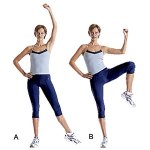
#1. Side Shredder - 15x each side
2) Squat-Press – 12x
Holding dumbbells at ear-level with elbows bent. Lower into a squat, keeping the knees behind the toes. Push back up while pushing the weights overhead with the palms facing out.
- Keep head and neck in alignment throughout the movement
- Keep your weight in your heels. Make sure your knees don’t go past your toes when squatting.
- Use medium-heavy weights for this exercise.

#2. Squat Press - 12x
3) Wall Pushup – 15x
Stand facing a wall and extend your arms in front of you. Lean forward slightly and place your palms against the surface. Bend your elbows until your nose nearly touches the wall. Push back out to start. That’s one rep.

#3. Wall Pushup - 15x
4) Alt. Canoe Row – 12x each side
Stand with your feet 3 feet apart, knees slightly bent, and hands clasped. Keeping your hips still, bring your hands down to your left hip, “paddling” backward. Next, raise your hands up to chest level, and then paddle them to the right hip. Do 10 alternating reps for each side. If it’s too easy, hold a 2- to 5-pound dumbbell in each hand.
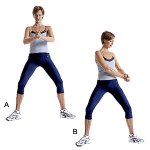
#4. Alt. Canoe Row - 12x each side
5) Straight Arm Pulldown – 12x
Start by grabbing the band, or wide bar from the top pulley of a pulldown machine and using a wider than shoulder-width pronated (palms down) grip.
Step backwards two feet or so. Bend your torso forward at the waist by around 30-degrees with your arms fully extended in front of you and a slight bend at the elbows.
While keeping the arms straight, pull the bar down until your hands are next to the side of the thighs. Breathe out as you perform this step. While keeping the arms straight, go back to the starting position while breathing in.

#5. Straight Arm Pulldown - 12 x
6) Alt. Plie’ and Reach – 10x ea side
Stand with your feet 3 feet apart and hands clasped. Contract your abs and perform a plie keeping your hands toward the floor. As you push up, raise your arms to the right. Next, lower your hands with another plie and then lift them to the left.
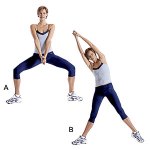
#6. Alt. Plie' and Reach - 10x each side
7) Standing Cable Chest Press – 12x
Attach the center of the band to a stationary object and hold one end in each hand. Stand with your back to the attachment, elbows bent (upper arm level with shoulder) so that your hands are next to your chest. Push forwards and straighten your arms out in front of you. Slowly return to the starting position

#7. Standing Cable/Band Chest Press - 12x
8) Elbow-Knee Crossover w/ Press – 12x each side
Stand with your shoulders in line with your hips, and extend your right arm up and your left leg to the side, toes pointed. Next, lower your right elbow and raise your left knee, crunching them together on a diagonal line. Return to start.

8. Elbow-Knee Crossover w/Press - 12x each side
9) Standing Wood Chop – 12x each side
Feet are shoulder width apart, toes slightly out…keep knees slightly bent. Just like having an ax, bring your hands together (holding a ball or dumbbells if you want) and extend arms to the top right of your body. Swinging down and across the body to the bottom left, sit hips back and bend knees into a slight squat. Always have your chest facing the move. Repeat on other side.
**Variation: you can stand with feet extra wide, performing the same chopping move. Instead of squatting, side-lunge to the left, bringing hands down to the inside of the left ankle.

#9. Standing Woodchop - 12x each side
Pictures and some descriptions courtesy of Women’s Health Magazine and Men’s Health Magazine.


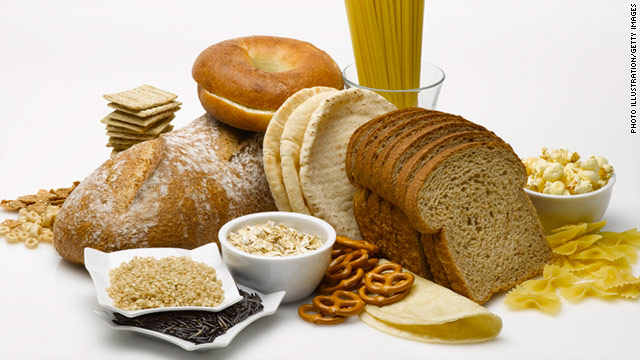












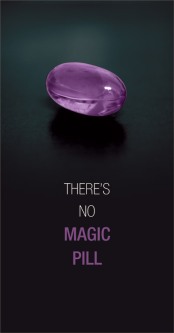 nt the body from absorbing carb calories and thereby promote weight loss. Because white kidney bean inhibits the breakdown of carbohydrates, it can reduce the glycemic load of foods such as white bread and potatoes. White kidney bean may be a viable complementary treatment for people with diabetes.
nt the body from absorbing carb calories and thereby promote weight loss. Because white kidney bean inhibits the breakdown of carbohydrates, it can reduce the glycemic load of foods such as white bread and potatoes. White kidney bean may be a viable complementary treatment for people with diabetes.



